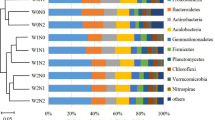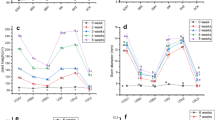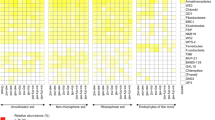Abstract
ALTHOUGH considerable work has been done on the influence of various factors such as type, moisture content, reaction and treatment of the soil and kind and age of plant on the microflora of the rhizosphere1, very little has appeared concerning the response of the normal rhizosphere micropopulation to the changes in plants growing under different light intensities. The studies that have been made deal primarily with specific phenomena such as symbiotic nitrogen fixation2, mycorrhizal development3 and susceptibility of roots to infection4. However, Rovira5 has recently reported that “the numbers of bacteria in the rhizosphere of tomato were reduced by 60 per cent when plants were shaded to 40 per cent of full sunlight”; the conditions under which the plants were grown were not given. We have recently completed experiments on the influence of light on the microbial population of wheat roots. These were selected for analysis rather than the soil adhering to them because it was considered that the organisms in intimate contact with the roots would reflect more accurately the changes produced in the plant by differences in illumination than would the organisms in the rhizosphere soil, where a dilution of the effect would probably occur. Certain of our findings relating to the bacterial flora are presented here. Full details of these experiments will be published elsewhere.
This is a preview of subscription content, access via your institution
Access options
Subscribe to this journal
Receive 51 print issues and online access
$199.00 per year
only $3.90 per issue
Buy this article
- Purchase on Springer Link
- Instant access to full article PDF
Prices may be subject to local taxes which are calculated during checkout
Similar content being viewed by others
References
Katznelson, H., Lochhead, A. G., and Timonin, M. I., Bot. Rev., 14, 543 (1948).
van Schreven, D. A., in “Nutrition of the Legumes”, edit. by Hallsworth, E. G. (Butterworths Scientific Publications, London, 1958).
Björkman, E., Svensk. Bot. Tidskr., 43, 223 (1349).
Foster, R. E., and Walker, J. C., J. Agric. Res., 74, 165 (1947).
Rovira, A. D., Plant and Soil, 11, 53 (1959).
Lochhead, A. G., and Chase, F. E., Soil Sci., 55, 185 (1943).
Katznelson, H., and Rouatt, J. W., Canad. J. Microbiol., 3, 265 (1957).
Lochhead, A. G., and Thexton, R. H., Canad. J. Res., C, 25, 20 (1947).
Eaton, F. M., and Rigler, N. E., J. Agric. Res., 72, 137 (1946).
Harley, J. L., and Waid, J. S., Plant and Soil, 7, 96 (1955).
Stakman, E. C., and Harrar, J. G., “Principles of Plant Pathology” (Ronald Press Co., New York, 1957).
Ellenby, C., Ann. App. Biol., 32, 67 (1945).
Author information
Authors and Affiliations
Rights and permissions
About this article
Cite this article
ROUATT, J., KATZNELSON, H. Influence of Light on Bacterial Flora of Roots. Nature 186, 659–660 (1960). https://doi.org/10.1038/186659a0
Issue Date:
DOI: https://doi.org/10.1038/186659a0
This article is cited by
-
Responses of soil biota to elevated atmospheric carbon dioxide
Plant and Soil (1994)
-
Elevated atmospheric CO2 effects on seedling growth, nutrient uptake, and rhizosphere bacterial populations ofLiriodendron tulipifera L.
Plant and Soil (1987)
-
The rhizosphere microflora of wheat grown under controlled conditions I. The effect of soil fertility and urea leaf treatment on the rhizoplane microflora
Plant and Soil (1978)
-
The rhizosphere microflora of wheat grown under controlled conditions II. Influence of the stage of growth of the plant, soil fertility and leaf treatment with urea on the rhizosphere soil microflora
Plant and Soil (1978)
-
Investigations into rhizosphere microflora
Plant and Soil (1971)
Comments
By submitting a comment you agree to abide by our Terms and Community Guidelines. If you find something abusive or that does not comply with our terms or guidelines please flag it as inappropriate.



